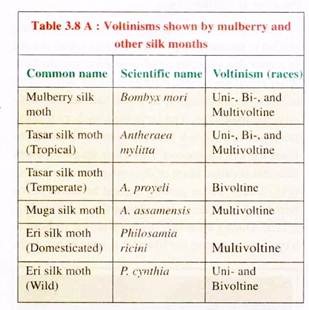In this article we will discuss about Voltinism:- 1. Meaning of Voltinism 2. Characteristics of Voltinism 3. Control.
Meaning of Voltinism:
Voltinism can be defined as the number of broods or generations produced in a year in the life cycle of silk moth under natural conditions. Mulberry and other silk moths show different races based on voltinism (Table 3.8A).
Characteristics of Voltinism:
(1) Univoltine:
These silk moths hatch once a year, so have one generation per year. These moths lay only hibernating eggs. In these eggs, the embryo enters diapause after partial development and hatches out during the following spring. So they produce only one brood per year. 
ADVERTISEMENTS:
ADVERTISEMENTS:
ADVERTISEMENTS:
(2) Bivoltine:
These moths hatch twice a year, thus having two generations per year. The egg-laying behaviours of bivoltine moths are intermediate. They can lay non-hibernating eggs during first generation and hibernating eggs in the next generation from which the embryo hatches out in the following spring; thus they produce two generations in a year.
(3) Multivoltine:
These moths can hatch several times in a year, so may have multiple generations per year. They lay only non-hibernating eggs where the embryo develops without any diapause and hatches out in about 10 days. Thus, they can produce multiple generations in a year.
Control of Voltinism:
Voltinism of silk moths are controlled by genetic, environmental and hormonal factors:
(i) Environmental Factors:
Temperature and light are most important for voltinism. Incubating the eggs from bivoltine race at temperature of 15-18°C with short photoperiod (12 hours) can make the moths to appear and depose non-hibernating eggs (2 generations/year). If eggs are incubated at high temperature of 25-28°C with long photoperiod of 12-14 hours, moths appear and depose hibernating eggs (one generation / year).
(ii) Genetic Factors:
Voltinism is attributed to a number of 3 multiple sex alleles (Hs. Hs2, hs) modified by a number of autosomal genes (H1, h1; H2, h2; H3. h3) (A-Matei. 2005).
ADVERTISEMENTS:
(iii) Hormonal Factors:
Diapause hormone (DH) secreted from suboesophageal ganglia is known to control diapause or otherwise voltinism in silk moths.